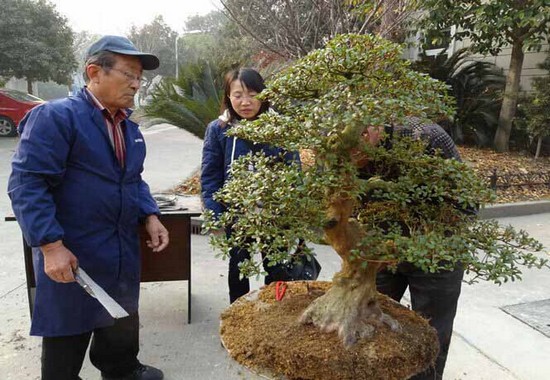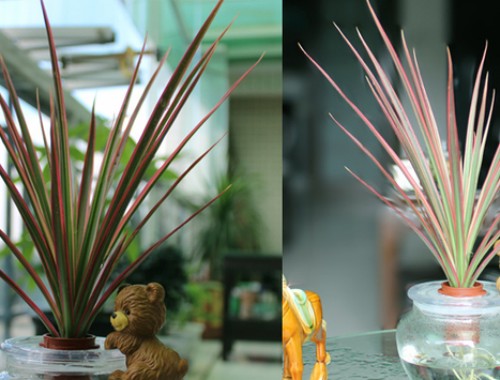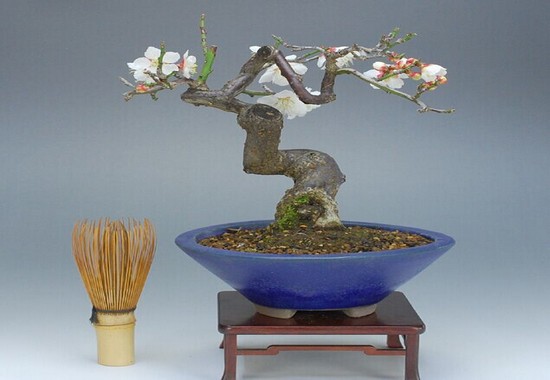An attempt not to change the soil of bonsai
According to the traditional concept, bonsai should be changed every two or three or four or five years. This heavy work cost us a lot of manpower, material resources and time. Especially for large-scale production and collection units, changing pots has become a big burden.
At first, I also changed the soil every three or four years. When I was tired and troublesome, I always wondered if there was a good way not to change the soil, so I began to try it in the early 1980s. At first I was worried about failure. Later, the pot of ancient lohan pine in my old friend's house helped me make up my mind.

It was the spring of 1983, and I saw an old green pottery pot planted with a well-growing Luohan pine in my old friend's house. My 76-year-old friend told me that the potted plant was handed down from his ancestors. He didn't take much care of it at ordinary times. He poured enough water when the soil was dry, applied compound fertilizer with a concentration of no more than 2% in spring, summer and autumn, and never changed the soil. He only changed the soil from a smaller basin on the eve of liberation. The original tire was changed into this larger green pottery basin in front of him, and the soil has not been changed for 34 years. This accidental discovery strengthened my determination to try bonsai not to change the soil.
When new viewpoints or theories are put forward, we must not rush for quick success and quick profit, and we should not come to a conclusion when we catch one or two accidental discoveries. In order to stand the test of time and plants, from the spring of 1984 to the autumn of 1985, I planted 200 pots of large and medium-sized tree stumps (all over 50 years old) with my own potted soil, and 200 pots of miniature (11.5 X 7.5 X 3.5 cm) bonsai. It involves nearly 20 kinds of plants, such as banyan, park, wax plum, elm, sparrow plum, yellow poplar, bauhinia, pomegranate, cycad, crape myrtle, tiger thorn, Michelia, gardenia, dragon boat flower, Luohan pine, j horn plum and so on. By 2008, the 400 potted bonsai had not been changed except that the 12 pots of medium-sized stumps had grown too big and the original soil tyres had changed the No. 1 pot of the National people's Congress. There are 2 medium-sized pots, 1 large basin and 5 miniature pots. The bottom of the ferocious basin was blocked and died without taking timely measures. The failure rate was 2%. The rest grew well, and flowers and fruits still blossomed and bear fruit. In my opinion, this 2% of failures can be avoided if problems are identified in time and appropriate measures are taken.
Can potted soil adapt to the growth of potted trees without changing it for decades or even hundreds of years? The key lies in whether there is a proper gap in the basin soil and whether it can ensure the normal metabolism of the root system. The formation of basin soil voids mainly comes from two aspects: one is the insoluble soil particles of different sizes, which is the original condition for the formation of basin soil voids; the other is the natural decay of the root system, which is an auxiliary factor. These two points will form a network-like gap channel, so that water, fertilizer, air and other normal storage and circulation in the basin soil, to ensure the normal metabolism of basin trees.
If you want to keep the bonsai from changing soil, the preparation and use of basin soil is very important. The primary basin soil must be a matrix with low viscosity, low solubility and good permeability. By comparison, I chose pure cinder. The pH value of cinder is neutral and can be widely adapted to the growth of all kinds of plants; its viscosity is very small and it is difficult to dissolve and bond into cakes that lack permeability, which is conducive to the formation of network-like voids; it also contains a variety of minerals and can provide a variety of trace elements. After the matrix is selected, the methods of preparation and use can not be ignored. First of all, the cinder will be mashed into particles, sifted out the powder, divided into two specifications, one is about 2 cm in diameter, the other is a mixture with a diameter of less than 1.5 cm, separate and set aside. When planting, first use tiles to set up a water channel at the basin bottom outlet, then evenly pad a layer of cinder with a diameter of about 2 cm, then firmly plant the pot trees with mixed cinder less than 1.5 cm, and finally spread a layer of 2 cm-sized cinder block to protect the middle mixture. Do not fill too full, the basin should leave some space, in order to facilitate the future management of fertilizer and water.
The daily management is the same as the traditional bonsai. Attention should be paid to: first, dry water thoroughly, do not dry do not water; thin fertilizer frequently applied, spring, summer and autumn can be once a month, the use of compound fertilizer must be mixed into an aqueous solution, the concentration is not more than 2%. Second, keep the m-nozzle at the bottom of the basin unobstructed to prevent the root system from protruding from causing blockage. Third, when potted trees need to change pots because of growing up or creation, they can only change pots without changing soil. When changing the basin, first use tiles to set up the passage at the outlet of the new basin bottom, and then put on a layer of 2 cm-sized cinder block, then remove the whole or a small part of the surrounding old soil from the original basin, move it into the new basin, and fill it with cinder with a diameter of 1.5 cm or less, and cover the basin with a 2-cm cinder block. The basin change procedure is complete.
The above is the author's attempt in the past 23 years. At the end of writing, I always feel that my views need to be studied by more colleagues in order to enrich and develop them. May my work become a brick to attract jade.
Time: 2019-05-23 Click:
- Prev

Formaldehyde bonsai in the bedroom
The bedroom is a place for people to sleep and rest, and it is appropriate to create a beautiful and quiet atmosphere. Large flowers cannot be put in the bedroom. although plants produce oxygen, they absorb oxygen without photosynthesis at night, which is not good for people's health, and can not raise flowers with fragrance, which stimulates nerves and affects the quality of sleep.
- Next

What is a sketch bonsai? What kind of creative ideas do you have?
In today's society, potted plants take up the least space in the world of enjoying potted plants. Small roofs and balconies can cultivate more than 100 potted potted sketches. In addition, the price of potted materials for sketches is cheaper than that of medium-sized and large-scale ones, and it can be played and appreciated without much cost, and it won't hurt so much even if the creation fails.
Related
- Fuxing push coffee new agricultural production and marketing class: lack of small-scale processing plants
- Jujube rice field leisure farm deep ploughing Yilan for five years to create a space for organic food and play
- Nongyu Farm-A trial of organic papaya for brave women with advanced technology
- Four points for attention in the prevention and control of diseases and insect pests of edible fungi
- How to add nutrient solution to Edible Fungi
- Is there any good way to control edible fungus mites?
- Open Inoculation Technology of Edible Fungi
- Is there any clever way to use fertilizer for edible fungus in winter?
- What agents are used to kill the pathogens of edible fungi in the mushroom shed?
- Rapid drying of Edible Fungi

